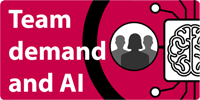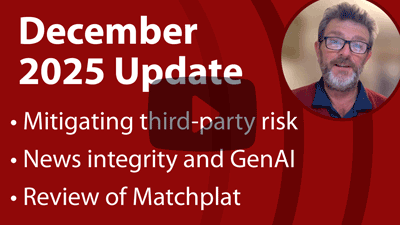 Future proofing your team for GenAI
Future proofing your team for GenAI
Jinfo Blog
17th June 2025
Abstract
Item
The more I understand about GenAI, the more convinced I am that it will reshape the role of information teams, not replace it. Because AI is good at doing some things, but not others.
The key to charting your response to GenAI is to recognise its strengths and weaknesses, and position your team to address the weaknesses of the technology.
Deterministic vs probabilistic systems
Information teams have long worked with deterministic systems. Products and tools built on clear rules and logic.
These systems are predictable, consistent, reliable, and repeatable.
As long as the data and metadata are correct, the output will be accurate. Even if the underlying data is wrong, the systems still produce the same (incorrect) result, every time.
Information teams' reputations are built on providing accurate, reliable, dependable information to guide stakeholders' decisions. Perhaps we should resurrect the term "information scientists"?
A by-product of this is an abundance of caution, and aversion to risk.
By contrast, GenAI uses probabilistic systems. They draw on vast datasets, external knowledge and contextual cues, to generate the "most likely" answer a user expects.
AI systems refine results over time, "learning" from new data and users' behaviour, introducing new variables into the research and retrieval equation.
They also make mistakes. Recent studies indicate that the accuracy of the latest models has actually declined.
Even more worrying is that the latest iterations of GenAI are generating more hallucinations, as models are tweaked to be more "creative" to give the impression of being more "intelligent"!1
It should be no surprise then, that information vendors are struggling to reconcile the legacy use-cases of their deterministic systems with the probabilistic potential of GenAI. See, for example, the Jinfo Article "The impact of AI on news content, with the Financial Times".
What are the use cases?
If stakeholders need information that must be right all the time, they cannot rely on GenAI for their research.
GenAI should not be applied to use cases that are badly suited to its capabilities.
These high-stakes use cases could include:
- Work for external clients
- Legal or regulatory research
- Court filings
- R&D inflection points
- Compliance screening, including "know your client", "know your supplier", sanctions checks.
But, there will be non-critical use-cases where GenAI is "good enough", for instance:
- Idea generation
- Brainstorming
- Early-stage research
- Identifying emerging trends
- Drafting material that will be checked by experts.
See the Jinfo Blog "Why AI should enhance, not replace your research team".
How can information managers build their strategy around GenAI?
- Start by documenting your research work by use-case. This will give you insights into what work should be retained by your team, and what can be delegated to GenAI.
- Consider how the information team can use GenAI to improve their own efficiency and effectiveness. For example, legacy systems can be used for accurate searching, and GenAI used to summarise or synthesise the responses - licences permitting!
- Determine the need for human oversight of GenAI outputs (a pre-requisite for the foreseeable future). And determine what investment is needed to raise the skills and capacity of the information team to support that workload.
- Understand the appetite for training and coaching of the critical skills needed by the wider workforce to use GenAI tools. Decide if/how the information team can support the GenAI training and development needs of the wider organisation.
Closing thoughts
These developments will elevate the work of the information team and enhance the business-critical contributions of the function. But, it will require greater expertise and critical thinking on the part of the team to work at this level.
It will also help your stakeholders recognise the potential of GenAI, and mitigate the risk by matching inappropriate use-cases to GenAI technology.
For more, see the Jinfo Report "How can information managers bridge the AI knowledge gap?".
1 "AI hallucinations are getting worse, and they're here to stay", New Scientist, May 2025
- Blog post title: Future proofing your team for GenAI
- Link to this page
- View printable version
Register for our next Community session:

Team demand and AI
22nd January 2026
Latest on our YouTube channel:
Read on the Blog:
December 2025 update
3rd December 2025
- Team roles and AI (Community) 26th February 2026
- Team demand and AI (Community) 22nd January 2026
- Transforming knowledge management at BASF – GenAI and the evolution of QKnows (Community) 10th December 2025